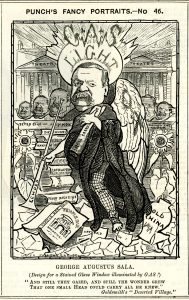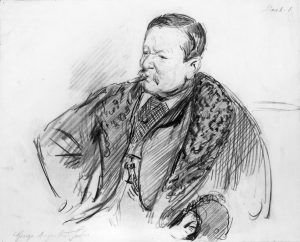George Augustus Sala (1828-1895)
Dubbed by Joseph Hatton as the ‘chief of travelled specials’ (Journalistic London, 1882, p. 169), George Augustus Sala’s potential as a Special Correspondent was first demonstrated when he was sent to Russia to obtain material for a series of papers on Russian life and manners for Household Words, the cheap weekly miscellany that Charles Dickens edited throughout the 1850s. Indeed, in its published sketches of travel abroad, Household Words provided him with an apprenticeship in the techniques of journalistic ‘word-painting’ that would subsequently come to distinguish his work as a Special for the fledgling Daily Telegraph in 1857, an association he continued until just before his death. Over the course of a fifty-year career in newspaper and periodical journalism, he despatched correspondence from many parts of the world, including Algeria, Australia, New Zealand, America and a number of European countries. As he wryly described the multifarious demands placed upon the Special Correspondent in 1871, ‘He must be Jack of all trades, and master of all – that are journalistic’:
[W]hen there is no war afoot, he must be prepared to ‘do’ funerals as well as weddings, state-banquets, Volunteer reviews, Great Exhibitions, remarkable trials, christenings, coronations, ship-launches, agricultural shows, royal progresses, picture-shows, first-stone layings, horse-races, and hangings.
(‘The Special Correspondent’, Belgravia, April 1871, p. 221).
Punch’s caricature, by Linley Sambourne, pokes fun at Sala’s distinctively allusive and eclectic style of writing. It references his long-running ‘Echoes Of The Week’ (1860-1887) column in the Illustrated London News, his editorship of Temple Bar and long association with the theatre.

[Linley Sambourne,] ‘Punch’s Fancy Portraits – No. 46: George Augustus Sala’, Punch, 27 August 1881, p. 94.
Image courtesy of the British Cartoon Archive, University of Kent. www.cartoons.ac.uk

George Augustus Sala at the Parnell Commission, Sydney Prior Hall, pencil, published in The Graphic 16 March 1889, NPG 2260.
© National Portrait Gallery, London
Sala’s highly popular style of word-painting drew criticism from conservative commentators, like Matthew Arnold, who deplored what they saw as the philistinism of a commercially-driven press deploying sensational reportage to sell newspapers. But his influence was nevertheless remarkable, as his contemporary T.H. S. Escott observed: ‘Never was there a journalist who had so thoroughly mastered the tastes and requirements of the colossal circle of readers to which he appeals. Seldom has there been one of whom it may be said that he has created the appetite which his writings satisfy.’ (‘A Journalist of the Day’, Time 1 (1879), p. 120).